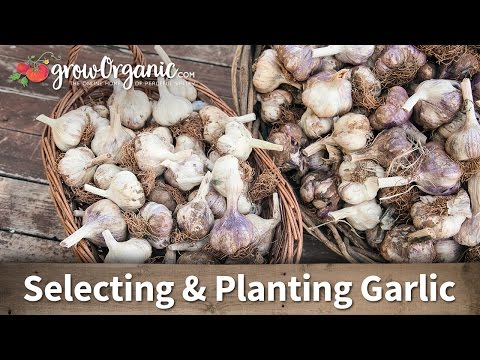Item Number: FP515
Organic Sicilian Garlic (lb)
Flavorful, stores well, gardeners’ favorite
- Produces 10-15 cloves per bulb.
- Supports the cultivation of 70-100 plants per pound.
- High yield potential.
- Cold hardy, thriving even in the northernmost regions.
- Notable for its excellent flavor.
- Ideal for braiding, with a storage lifespan of up to nine months.
- Highly suitable for market gardening.
Growing Organic Sicilian Garlic: A Comprehensive Guide
Sicilian garlic, renowned for its robust flavor and excellent storage capabilities, is a favorite among both home gardeners and commercial farmers. This variety, categorized as an Artichoke garlic, is not only a heavy producer but also exceptionally cold hardy, making it suitable for various climates, including the northernmost regions. Below is a detailed guide on growing organic Sicilian garlic, covering everything from planting to harvesting and storage.
Choosing the Right Bulbs
When selecting garlic bulbs for planting, it is crucial to choose seed garlic that is organic and free from disease. Sicilian garlic bulbs can grow quite large, sometimes over 1/4 lb, making them an excellent choice for market gardeners due to their high yield and significant size. On average, you can expect 10-15 cloves per bulb, with 6-8 bulbs per pound. This translates to about 70-100 plants per pound of garlic.
Site Selection and Soil Preparation
Garlic thrives in well-drained soil with a pH between 6.0 and 7.0. Choose a sunny location for your garlic farm, as garlic plants require plenty of sunlight to develop strong bulbs. Prepare the soil by adding organic compost or well-rotted manure to ensure it is fertile and rich in nutrients. If your soil is heavy clay, consider adding sand or other organic matter to improve drainage.
Planting Time and Method
The best time to plant Sicilian garlic is in the fall, about 4-6 weeks before the ground freezes. This timing allows the garlic to establish roots before winter, leading to a stronger plant in the spring.
Separating Cloves: Carefully break apart the garlic bulbs into individual cloves, ensuring each clove remains intact with its papery skin. This skin protects the clove and helps prevent rot.
Planting Depth and Spacing: Plant each clove about 2-3 inches deep, with the pointed end facing up. Space the cloves 6-8 inches apart in rows that are 12-18 inches apart. Proper spacing ensures adequate airflow and reduces the risk of disease.
Watering and Mulching
Garlic requires consistent moisture, especially during the initial growth period. Water the plants regularly, but avoid overwatering, as garlic does not tolerate waterlogged soil. Mulching is highly beneficial for garlic. Apply a thick layer of organic mulch, such as straw or shredded leaves, after planting. Mulch helps retain soil moisture, suppress weeds, and protect the garlic from extreme temperature fluctuations.
Fertilization
Garlic is a heavy feeder, it benefits from a balanced fertilization program. Incorporate a slow-release organic fertilizer into the soil at planting time. Throughout the growing season, you can side-dress with compost or an organic fertilizer high in nitrogen to promote healthy leaf growth, which in turn supports larger bulb development.
Weed Control and Maintenance
Keeping your garlic bed weed-free is crucial, as weeds compete with garlic for nutrients and water. Regularly inspect your garlic farm and remove weeds by hand to avoid disturbing the garlic bulbs. Mulching significantly reduces the weed burden, but occasional weeding may still be necessary.
Pest and Disease Management
It is relatively hardy and resistant to many common pests and diseases. However, it can still fall prey to issues like garlic rust, white rot, and nematodes. To minimize these risks, practice crop rotation, avoid planting garlic in the same spot more than once every three years, and ensure good air circulation around the plants. If you notice any signs of disease, remove affected plants promptly to prevent spread.
Scape Removal
In the late spring to early summer, garlic plants produce flower stalks known as scapes. While these are edible and can be harvested for culinary use, removing them encourages the plant to direct its energy toward bulb development rather than flowering. Cut the scapes as they begin to curl, ideally before they form full flower heads.
Harvesting
Garlic is typically ready for harvest in early summer when the lower leaves start to yellow and dry. Do not wait until all the leaves have died back, as this can lead to overripe bulbs that may split or be more susceptible to disease.
- Harvest Timing: Choose a dry day for harvesting. Loosen the soil around the bulbs with a garden fork, being careful not to damage them, and gently pull the plants from the ground.
- Curing: After harvesting, garlic needs to be cured to ensure proper storage. Hang the plants in bunches or spread them out in a well-ventilated, dry area away from direct sunlight. Allow the garlic to cure for 3-4 weeks until the outer skins are papery and the bulbs are fully dry.
Flavor and Aroma Profile
-
Flavor Profile: It is prized for its robust, zesty flavor with a mellow, slightly sweet finish. This softneck variety delivers a classic garlic taste that intensifies when cooked but remains smooth and rich. It’s particularly suited for Italian cuisine, complementing everything from hearty pasta sauces to savory roasted vegetables and grilled meats.
-
Aroma Profile: It gives off a warm, mildly spicy aroma with undertones of earthiness. The scent becomes more subdued and nutty when roasted, but in raw form, it retains a sharp and appetizing fragrance—perfect for infusing oils, salad dressings, or rubbing onto bread for bruschetta.
Storage and Preservation
How to Store Fresh Garlic
After harvesting in early spring, allow the green tops of Sicilian Garlic to dry completely and turn brown to ensure proper curing of the bulbs. Keep the softneck bulbs in a cool, dry, and well-ventilated area to retain their flavor and nutritional value. It is appreciated for its bold, slightly sweet flavor and impressive shelf life, making it a great all-purpose garlic for raw and cooked dishes alike.
Preserving Garlic for Long-Term Use
To preserve Sicilian Garlic for months, wait until the leaves have fully browned and the bulbs are mature before harvesting. Cure them in a dry, airy environment to maintain their flavor profile and firm cloves. This softneck variety performs beautifully in a wide range of recipes—from roasted vegetables to vinaigrettes—and remains a flavorful kitchen staple long after harvest.
Best Practices for Drying and Freezing
Freezing garlic after it has been properly cured is an excellent method to preserve its flavor and usability. For this garlic, you can freeze whole bulbs, peeled or unpeeled cloves, or even minced garlic—depending on how you intend to use it in the kitchen. While it is possible to freeze garlic right after harvest, it's generally discouraged. Fresh, uncured garlic contains higher moisture levels, which can lead to a mushy texture and diminished flavor after thawing.
Benefits and Uses
It is prized for its excellent flavor, making it a staple in various culinary dishes. It contains allicin, a compound with potential health benefits, including antimicrobial properties. Additionally, its high yield and good storage qualities make it a valuable crop for both personal use and market gardening.
Growing this garlic involves careful selection of planting stock, proper soil preparation, timely planting, and diligent maintenance. By following these guidelines, you can enjoy a bountiful harvest of flavorful, long-storing garlic that enhances both your kitchen and your health. Whether you are a home gardener or a commercial grower, it is a rewarding and valuable addition to your crop repertoire.
Why Order From Us?
We proudly offer premium softneck garlic varieties like Organic Sicilian Garlic, grown with care by expert cultivators to ensure superior quality and excellent storage potential. Sold by the pound, this variety excels in fall planting and is well-suited for milder winter climates. Order today to explore our curated collection of hardneck seed garlic varieties and softneck seed garlic varieties—perfect for growing a productive and flavorful home garden.
** For more information, see our Garlic Resource Center and try out our Garlic Selector Tool to find the perfect garlic for your growing zone and tastes. Or check out all of our Garlic Learning Blogs where our staff have selected dozens of articles, videos, recipes and tips to help you learn how to successfully grow garlic bulbs.**




Check Your Zone Compatibility:
Compatible with your zone.
Growing Zone for

Our Guarantee To You
Since 1976, we've served our customers at every stage of growing. Please contact us at any time. We are happy to support and assist you.
Shipping Information
Shipping Information
We cannot delay ship garlic/shallots. They will be shipped as soon as they are in stock.
Cannot ship to the following states: HI, ID, PR, GU, VI
Shipping Weight: 1.1 lb
Dimensions: 5.0"L x 3.0"W x 3.0"H
Features
Features
- Bulb
- Container Compatible
- Easy to Peel Cloves
- Softneck
- Spicy Flavor
- Suited to Cold Climates
- WSDA Certified Organic
Characteristics
Characteristics
Planting & Care
Planting & Care
Useful Information
Useful Information
Guarantee
Guarantee
Limited Seed Garlic Guarantee (When Planted by November 15th)
Claim Deadline is 45 Days from Purchase or Delivery. (Claims placed after December 31st will be denied.)
What We Guarantee
Our only guarantee is that the seed garlic we sell will germinate, provided you follow the steps listed in our Garlic Planting & Growing Guide. This guarantee is only available to customers who purchase their seed garlic directly from us.
What We Cannot Guarantee
We cannot guarantee that your garlic will remain alive & healthy, or sizes up properly, as there are too many variables beyond our control to be able to do so (i.e. soil preparation, fertilization, weed and pest control, temperature control, irrigation, etc).
How to Request a Credit
If you encounter a significant lack of germination of your garlic (over 50%), please contact us within 45 days of delivery. If we determine that your garlic had a significant lack of germination, we will issue you a credit (not a refund) for the purchase price of your garlic (excluding shipping).* This 45-day time frame is meant to allow you up to 2 weeks to plant your garlic, and up to 4 weeks to check for signs of growth.
(*) We reserve the right to not issue credit for items already replaced. We also reserve the right to require photographic evidence of the lack of germination of your garlic.
Share



I have not had a chance to plant these yet as it’s still a little early. Package came quickly and garlic was beautiful, can’t wait to plant it.









